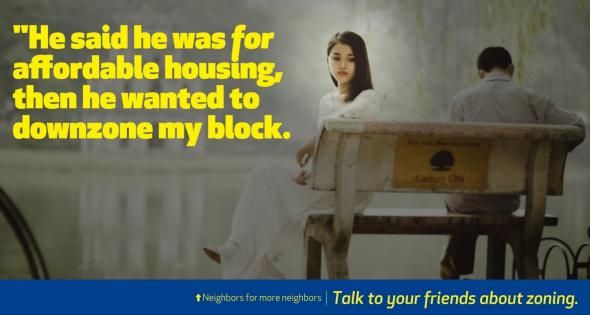Physical Address
304 North Cardinal St.
Dorchester Center, MA 02124
Physical Address
304 North Cardinal St.
Dorchester Center, MA 02124

Believe it or not, the YIMBY movement won a lot in 2018. It kicked off with January’s high of California State Senator Scott Wiener’s introduction of SB 827, which would have permitted multifamily development near transit across the state, but fell to a low after its eventual defeat in committee, invariably followed by a flurry of think pieces about how the pro-development movement had “failed.” At the time, I made the case for optimism over on Citylab, but that didn’t stop the summer lull from becoming a period of soul searching within the movement. And then, a strange thing happened: YIMBYs started winning, and winning big. In August, presidential-hopeful Senator Cory Booker released a plan to preempt exclusionary zoning using Community Development Block Grant funds, quickly followed by a similar plan from Senator Elizabeth Warren in September. Also in August, Housing and Urban Development Secretary Ben Carson unexpectedly outed himself as a YIMBY. Then, in December, things really got crazy: two major North American cities, Minneapolis and Edmonton, completely eliminated single-family zoning. States like Oregon soon started talking about doing the same. In the same month, California kicked into overdrive: San Francisco—ground zero for the YIMBY movement—scrapped minimum parking requirements altogether. State Senator Wiener introduced a newer, sharper version of SB 827. And rolling into 2019, elected officials at every level of California government—from the state’s new Democratic governor to San Diego’s Republican mayor—are singing from the YIMBY hymn sheet. All in all, it wasn’t a bad year for a movement that’s only five years old. But what really made 2018 such an unexpected success for YIMBYs? Focus on Citywide Reform Over Individual Rezonings Showing up and saying “Yes!” to individual projects that are requesting a rezoning, variance, or special permit is bread-and-butter YIMBY activism. And while YIMBYs should still […]

It’s an understatement to say that zoning is a dry subject. But in a new video for the Institute for Humane Studies, Josh Oldham and Professor Sanford Ikeda (a regular contributor to this blog) manage to breath new life into this subject, accessibly explaining how zoning has transformed America’s cities. From housing affordability to mobility to economic and racial segregation to the Jacobs-Moses battle, they hit all the key notes in this succinct new video. If you need a go-to explainer video for the curious new urbanists, this is the one. Enjoy!

On August 23rd, a California assembly bill aimed at increasing transit-oriented development, like housing, was passed by the state senate, confirmed by the assembly, and headed to Governor Jerry Brown’s desk for signing. The bill, AB 2923, specifically targets the San Francisco Bay Area—making it easier than ever for the Bay Area Rapid Transit (BART) to build housing on the land it owns around its transit stations. Previously, housing developments on BART-owned land were still subject to local zoning rules, pushing projects through local processes to be approved before building began. This local control led to many delays, and, as a result, housing denials in the midst of an ongoing housing shortage—on that repeatedly spurs news headlines decrying four-plus hour super commutes, median home prices over $1 million, and neighborhoods blocking affordable housing. State bills like AB 2923 are a response to these reports, as well as the local control that led to them. If passed, AB 2923 and other bills like it, will bypass local control’s draconian rules to allow more housing to be built and ease the housing shortage. Under current law, land owned by BART is often subject to discretionary review in Bay Area cities. This forces BART to become de facto experts in every municipality zoning code, an impossible task that would take away from their focus on improving their transit system. Even attempting to master the zoning codes of every municipality takes time. Ultimately, this causes delays in building housing that’s so sorely needed. But this could easily be avoided if BART could establish their own zoning rules under AB 2923. Housing and transit is intrinsically linked and, just like suburban home developers build the roads to best suit their development, urban transit authorities like BART must utilize their capacity to build the homes best […]

In a recent blog post, Julia Galef has generated a fairly comprehensive list of pro-housing arguments and counterarguments to those arguments. She gives the most detailed consideration to the “infinite demand” argument- in her words, “So even if SF adds a lot of additional housing, prices will still rise almost as quickly as they would have anyway, as long as demand to live here continues to soar. This view is mainly based on examples of other desirable cities, like New York or Singapore, which have built new housing at a faster rate than SF but nevertheless saw steep increases in price.” To which I respond: New York? Really? New York is only pro-housing when compared to San Francisco- which is a bit like saying Iran is a libertarian paradise compared to the Islamic State. In fact, New York has built housing at a glacial pace. Between 1960 and 1976, the number of new housing units completed per year ranged from just over 14,000 to over 60,000, and exceeded 20,000 in all but four years. In the almost forty years since 1976, the number of new units exceeded 20,000 in only four years (2006-10) and was above 14,000 for only ten years (1989, 2002, 2004-10, 2015). Meanwhile, demand for housing has increased: between 2006 and 2014 alone, the citywide renter population grew by 600,000. A better example of a “desirable city” would be a city where both the population and the housing supply is growing at a rapid rate- Raleigh, for example, or Las Vegas. These cities are much cheaper than New York or San Francisco.* Another example of a cheap, permissive city is Tokyo. But the post suggests Tokyo may not have grown as fast as American cities. In fact, Tokyo’s regional population grew by 17 percent since 1990- from 32.5 million […]
I recently saw a Facebook post asserting that San Francisco has 30,000 vacant units, so therefore no market-rate housing should be built. So I looked up Census data on these allegedly empty units. It is true, according to the Census Factfinder website, that there are 30,000 or so unoccupied housing units in San Francisco. Does this mean that they are completely idle? In fact, no. More than half of these units were (as of the 2010 Census) currently for sale or for rent. 18 percent for for seasonal use (presumably, second homes). Only 5 percent are rented or sold but unoccupied. The rest are “other vacant”. whatever that means. Bottom line: half the vacancies were in the process of being sold or rented. A little under a fifth were second homes. About a third we don’t know much about.

The far-left “TruthOut” web page recently published an attack on YIMBYs,* describing them as an “Alt-Right” group (despite the fact that the Obama Administration is pro-YIMBY). I was surprised how little substance there was to the article; most of it was various ad-hominem attacks on YIMBY activists for cavorting with rich people. I only found two statements that even faintly resembled rational arguments. First, the article suggests that only current residents’ interests are worth considering in zoning policy, because “the people who haven’t yet moved in” most often means the tech industrialists, lured by high salaries, stock options and in-office employee benefits like massage therapists and handcrafted kombucha.” This statement is no different than President Trump’s suggestion that Mexican immigrants “[are] bringing drugs. They’re bringing crime. They’re rapists.” – that is, it is an unverifiable (if not bigoted) generalization about large numbers of people. Furthermore, it doesn’t make sense. The “tech industrialists” have the money to outbid everyone else, so they aren’t harmed by restrictive zoning. Second, the article states that academic papers aren’t as relevant as the actual experiences of San Franciscans displaced by high housing costs. In response to the argument that less regulation means cheaper housing, it states “tell that to people like Iris Canada, the 100-year-old Black woman who had used local regulations to stay in her home of six decades, only to be evicted in February.” So in other words, somebody was evicted in San Francisco, therefore San Francisco’s restrictive zoning prevents eviction. I don’t see how the latter follows from the former. The whole point of the YIMBY/market urbanist argument is that if there was more housing, there would be lower housing costs, hence fewer evictions. *For those of you who are unfamiliar with the term, YIMBY means “Yes In My Back Yard”, a […]
Last week, Reason.tv (the multimedia outlet of Reason Magazine) published a video about San Francisco’s YIMBY movement. The video describes the decades of underdevelopment in San Francisco as the result of community activism intended to limit the supply of new construction. As a result, San Francisco’s housing market is severely supply-constrained, and outrageously expensive. The problem has gotten so bad that pro-development, “YIMBY” organizations such as SFBARF and Grow San Francisco have sprung up to counter the anti-development forces. It’s great to see Reason taking notice of the YIMBY movement, and we’d love to see more attention paid to urbanism at libertarian sites. Three of us at Market Urbanism attended the first nationwide YIMBY conference in Boulder that the video mentions, and we’ll be sharing our thoughts on the conference soon. (h/t Jake Thomas at the Market Urbanism facebook group)
1. This week at Market Urbanism: Nolan Gray‘s latest post, Liberate the Garage!: Autonomous Cars and the American Dream At present, zoning laws effectively prohibit entrepreneurs from using their garages for business. In many Americans cities, hiring employees, hosting visitors, putting up signs, and altering your garage for business purposes are all outright banned. As urban planner Sonia Hirt notes in her most recent book, these regulations reflect American zoning’s dogmatic insistence on separating work from home. These restrictions effectively mandate sprawl by forcing commercial uses and residential uses into segregated districts. More troublingly, these regulations fall hardest on low-income entrepreneurs by significantly raising the cost of starting a business. The article was cited at streetsblog, and Nolan discussed the article on KCBS radio San Francisco Michael Lewyn wrote his first Market Urbanism article, Rent Control: A No-Win It therefore seems to me that pro-rent control municipalities are caught in a no-win situation: if they adopt strict rent controls, they limit housing supply by making housing a less attractive investment. But if they adopt temperate rent controls, they don’t really control rents. 2. Where’s Scott? Scott Beyer is leaving Oklahoma City tonight for Houston to see the rodeo. This week, he delved into foreign policy, writing in Forbes about The Case For Another Cuban Boatlift. Since 1980, Miami has been one of the fastest-growing metro areas by population, and has become one of the best for startup activity and upward mobility. Along with other Latin American immigrants, Cubans have bolstered this, making up over a third of the city’s population…Well into the 21st century, Cubans had among the highest median incomes and homeownership rates of U.S. Hispanic groups. 3. At the Market Urbanism Facebook Group: Michael Hamilton is happy to see good news for once: Arizona Senate Votes to Ban Cities from Banning Airbnb, Couch-Surfing Nick […]
1. This week at Market Urbanism: Nolan Gray contributed a post Who Plans?: Jane Jacobs’ Hayekian critique of urban planning discussing Jacobs’ three arguments against central planning: Hayek and Jacobs defended the importance of local knowledge, illustrated the power of decentralized planning, and celebrated the sublime spontaneous orders that organize our lives. Yet their theoretical innovations went largely unnoticed long after their respective publications. Here, the two thinkers diverge: while Hayekian ideas have largely driven centralized economic planning into the dustbin of history, I suspect the Jacobsian urban revolution has only just begun. The post was also discussed at Reason and Urban Liberty 2. Where’s Scott?: Scott Beyer is now in Oklahoma City, with plans to spend this weekend in Stillwater, OK. This week at Forbes, he described urban liberals’ inability to understand housing “filtering”: Officials believe that if new projects can’t be forced to charge lower prices, they shouldn’t be allowed at all. A smarter approach would be to view such projects the way one would view a gated community of mansions. Sure, such housing isn’t affordable, but it still serves a purpose: to provide rich people a place to live, thereby opening up older, smaller, less luxurious units for lower-income people. 3. At the Market Urbanism Facebook Group: Nolan Gray shared a CityLab piece quantifying the influx of young people in downtowns Private Protection Co. Puts Govt. Police to Shame in Detroit via Mark Frazier Bad news from John Morris: L.A. is seizing tiny homes from the homeless What Computer Games Taught Daniel Hertz About Urban Planning via Erik Genc 4. Elsewhere: Strong Towns spent the week discussing the numerous ways federal housing policies distort the marketplace against walkable urban environments. Lots of good reads and podcasts… Chicago plans to use Eminent Domain to seize the old Post Office and sell it. (when Chicago issues an RFP, […]
[this is a pilot for a regular weekly series rounding-up the week’s happenings in the world of Market Urbanism. I’d love to get your feedback in the comments or contact us directly. If the response is positive, we’ll continue it.] 1. Here at Market Urbanism, Scott Beyer wrote about Charlottesville developer Oliver Kuttner for his series on America’s Progressive Developers. Not uncommon in US cities, Kuttner faces ever increasing obstacles to innovative development: I do believe that every time you add an extra layer in city hall, you make interesting buildings less likely. 2. Scott was also quoted in The New Tropic about Miami gentrification: If you have a population increase and you don’t increase housing, people will get pushed out read the rest of the quote and article here. 3. At the Market Urbanism Facebook group: Nolan Gray shared some encouraging news about D.C.‘s new zoning code. Similar good news from Hartford, Connecticut! via John Morris China to build worlds largest Mega-City. “What could possibly go wrong?” asks Mark Frazier. Trump thinks Eminent Domain is wonderful via Anthony Ling. 4. Elsewhere: Michael Lewyn at Planetizen: Right to the City Daniel Hertz at City Observatory: In some cities, the housing construction boom is starting to pay off Dan Savage jumps on the SFyimby bandwagon: When It Comes to Housing, San Francisco Is Doing It Wrong, Seattle Is Doing It Right, Cont. Jonathan Coppage at The American Conservative: Why San Francisco Has to Build Up Kim-Mai Cutler at TechCrunch: A Long Game Chicago‘s proposed anti-Airbnb ordinance limits the number of nights a host can have guests, an additional 2% tax on top of Chicago’s 17.5% hotel tax, and possible jail-time for users! Let’s hope the opposition triumphs. Strong Towns interviews @stuckbertha (that Tunnel Boring Machine that got stuck 1,000 ft under Seattle) during #NONEWROADS week 5. And finally, Stephen Smith‘s tweet of […]